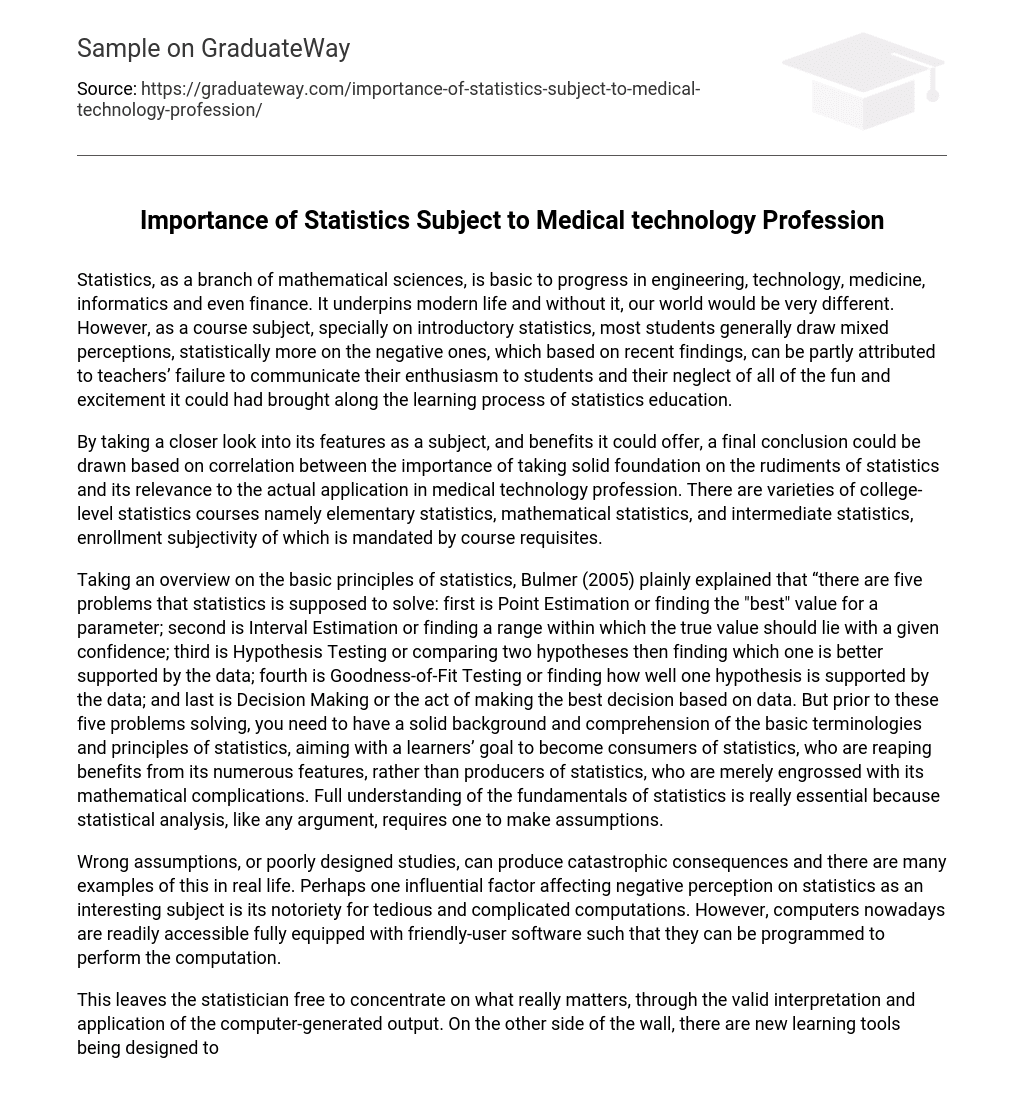Statistics, as a branch of mathematical sciences, is basic to progress in engineering, technology, medicine, informatics and even finance. It underpins modern life and without it, our world would be very different. However, as a course subject, specially on introductory statistics, most students generally draw mixed perceptions, statistically more on the negative ones, which based on recent findings, can be partly attributed to teachers’ failure to communicate their enthusiasm to students and their neglect of all of the fun and excitement it could had brought along the learning process of statistics education.
By taking a closer look into its features as a subject, and benefits it could offer, a final conclusion could be drawn based on correlation between the importance of taking solid foundation on the rudiments of statistics and its relevance to the actual application in medical technology profession. There are varieties of college-level statistics courses namely elementary statistics, mathematical statistics, and intermediate statistics, enrollment subjectivity of which is mandated by course requisites.
Taking an overview on the basic principles of statistics, Bulmer (2005) plainly explained that “there are five problems that statistics is supposed to solve: first is Point Estimation or finding the “best” value for a parameter; second is Interval Estimation or finding a range within which the true value should lie with a given confidence; third is Hypothesis Testing or comparing two hypotheses then finding which one is better supported by the data; fourth is Goodness-of-Fit Testing or finding how well one hypothesis is supported by the data; and last is Decision Making or the act of making the best decision based on data. But prior to these five problems solving, you need to have a solid background and comprehension of the basic terminologies and principles of statistics, aiming with a learners’ goal to become consumers of statistics, who are reaping benefits from its numerous features, rather than producers of statistics, who are merely engrossed with its mathematical complications. Full understanding of the fundamentals of statistics is really essential because statistical analysis, like any argument, requires one to make assumptions.
Wrong assumptions, or poorly designed studies, can produce catastrophic consequences and there are many examples of this in real life. Perhaps one influential factor affecting negative perception on statistics as an interesting subject is its notoriety for tedious and complicated computations. However, computers nowadays are readily accessible fully equipped with friendly-user software such that they can be programmed to perform the computation.
This leaves the statistician free to concentrate on what really matters, through the valid interpretation and application of the computer-generated output. On the other side of the wall, there are new learning tools being designed to improve education of statistics: a reform movement called for by responsible members of the academic community advocating for a revision in the introductory statistics course.
Changes are recommended in the following areas such as course content, pedagogy or the use of active learning, and thirdly, student assessment such as projects reports and writing assignments In furtherance of these reforms, faculty sectors are pursuing the following goals: less focus on computations; improve visualization of statistical concepts and processes, dynamic representations, and empowering students as users of statistics. Garfield, 2000) On the application side of statistics into medical sciences, most recent can be found in such areas as analyzing of brain scans, understanding Alzheimer’s Disease, computer-aided medical diagnosis and designing drug or field trials: technologies so familiar that unknowingly our love ones might already have availed of them and benefited from their applications.
Having examined principles of statistics as a course subject and the importance of possessing solid background on its rudiments relevant to medical technology as a career later would lead us now into a better perspective to finally conclude that taking statistics class, as an elective, much more as a prerequisite subject for the partial fulfillment of the requirements in medical technology course, is both academically imperative and an indispensable option; a mandatory prelude to a highly promising and lucrative profession.
Bibliography:
Bulmer, M. (2005). Principles of Statistics. New York: Dover Publications Inc. Garfield, J. , Chance, B. ; Laurie, J. . (2000). Technology in College Statistics Courses. Retrieved March 16, 2007, from http://www. dartmouth. edu/~chance/teaching_aids/books_articles/technology. html.





